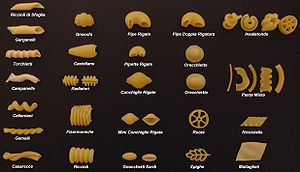When it comes to comfort food, there are few things more comforting on a cold night that a warm plate of perfectly cooked pasta. From linguine to orzo, spaghetti to spaetzle, pasta is one of the foods that you can find in every corner of the world. No matter where you go, there is likely to be some version of this inexpensive staple that populates the menus of the local restaurants and fills the memories of the local people.
Here in Arizona, we have a reputation for producing some of the highest-quality durum wheat grain on the planet. Pasta made from Arizona’s Desert Durum® has exceptional qualities like firmness and color that when paired with its long cooking tolerance, make it easy to see why pasta makers and chefs around the world love this Arizona-grown product.
This October 25th, let’s all put pasta on the menu in celebration of National Pasta Day.
In Italy, you will find linguine, rotini, and ziti. Go to Poland and you can order pierogies stuffed with a wide variety of fillings. In Asia, the noodles are made from both wheat and rice and you will find them everywhere you look. Here in America when we think of pasta, we generally think of the type of pasta popular in Italy and most often equate pasta with Italian cuisine. But for pasta lovers, there is no need to limit yourself to spaghetti and lasagna with so many other delicious pasts opportunities available.
Since pasta in one form or another is found in almost every regional cuisine around the world, it is very difficult to determine where it originated. Pasta is generally made with very simple ingredients like flour, eggs, and water which have been available since ancient times and are not region specific. It may be that pasta started everywhere, and no country can lay claim to creating this most beloved form of sustenance!
How Well Do You Know Your Pasta?
- Angel hair – The thinnest of the round rod shaped pastas.
- Cannelloni – Large, smooth tubes that can be stuffed.
- Couscous – Grain-like pasta.
- Farfalle – Bow-tie shaped noodles.
- Fettucine – Flat ribbon-like noodles.
- Fusilli – There are two common types of fusilli, lunghi which is a long coiled rod and bucati which is a long coiled tube.
- Gemelli – Spiral twist shaped noodle.
- Gnocchi – Round, oblong balls of pasta that are often made from a combination of flour and potatoes.
- Lasagna – Wide flat sheets with fluted edges.
- Linguine – Similar in thickness to spaghetti, only flattened rather than rod shaped.
- Manicotti – Large tubes with ridges that can be stuffed.
- Orecchiette – Small bowl shaped noodles.
- Orzo – Noodles shaped like rice.
- Pappardelle – Thick, flat ribbon-like noodles.
- Penne – Tubes with ridges that are medium length and are cut at a diagonal on both ends.
- Pierogi – Dumplings made with fresh unleavened dough and stuffed with a range of fillings.
- Ravioli – Square noodle pockets that are filled with other ingredients.
- Rigatoni – Large tubes with slightly curved ridged edges.
- Rotelle – Wagon-wheel noodles.
- Rotini – Tightly wound spiral noodle with two edges.
- Soba – Thinly cut buckwheat noodles used in Japanese dishes.
- Spaghetti – Made from wheat, round rod shape.
- Tortellini – Ring-shaped noodles that are stuffed with meat and/or cheese.
- Udon – Thick noodles made from wheat flour also found in Japanese cuisine.
- Vermicelli – Outside of the U.S., this pasta is a thicker version of traditional spaghetti noodles. Inside the U.S., it describes noodles similar to spaghetti only thinner.
- Ziti – Long narrow tubes that resemble a hose.
Related articles
- Perfecting Your Pantry: 10 Things to Always Have on Hand (fillyourplate.org)
- The Recent Beef? We’re Eating More Ground Beef and Less Steak (fillyourplate.org)
- 15 Things to Do With Chicken (fillyourplate.org)


